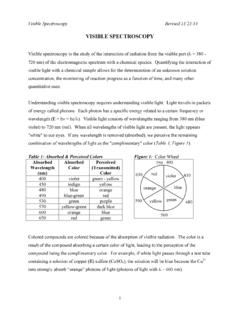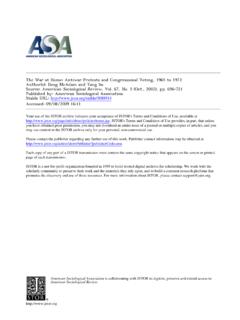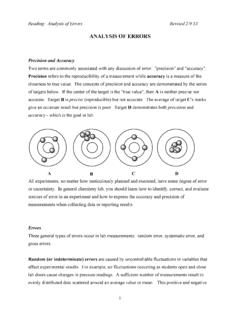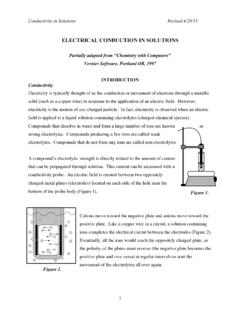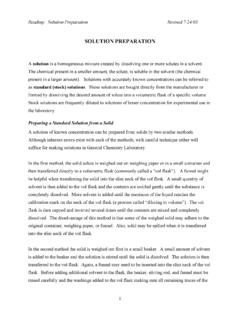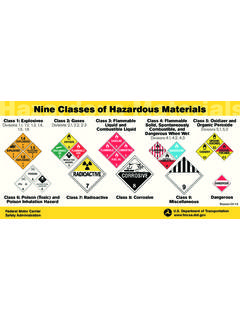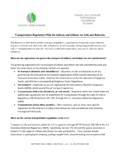Transcription of NFPA FIRE DIAMONDS & GHS SYMBOLS SAFETY DATA …
1 NFPA, GHS, & SDS Revised 4/11/14 NFPA fire DIAMONDS & GHS SYMBOLS SAFETY data SHEETS (SDS) The NFPA (National fire Protection Association) 704 or NFPA diamond is the standard for the identification of hazardous materials and emergency response. These signs can be found on reagent bottles, gas tanks, vehicles that transport chemicals, and doors to rooms containing certain chemicals. Their main purpose is to quickly indicate to first responders the dangers presented by the substances present. However, the fire diamond is useful for anyone, especially a student, who is handling chemicals. This diamond shaped sign is divided into 4 sections: health (blue, left), flammability (red, top), reactivity (yellow, right), and specific warnings (white, bottom).
2 For the first three categories, the severity of the danger is indicated by a scale of 0 (minimal hazard) to 4 (extreme hazard). Flammability Materials with Flashpoint Boiling Point 4 < 23 C (73 F) > 38 C (100 F) 3 < 23 C > 23 C > 38 C < 38 C 2 38 to 93 C 1 > 93 C (200 F) 0 material normally doesn t burn Reactivity material Behavior: Reactivity Conditions 4 explosion normal pressure & temperature 3 explosion strong initiating source 2 chemical change elevated pressure & temperature 1 unstable elevated temperature 0 stable Health Materials with an oral LD50 4 < 5 mg / kg 3 5 50 mg / kg 2 50 500 mg / kg 1 500 2000 mg / kg 0 > 2000 mg / kg Special W water reactive OX oxidizer COR corrosive radioactive Flammability Reactivity Health Special Notices NFPA, GHS, & SDS Revised 4/11/14 Definitions of terms used in the table above: Flash point: the lowest temperature at which a substance will vaporize and catch fire .
3 LD50 (median lethal dose): the amount of a substance needed to kill 50% of the population. Oxidizer (oxidizing agent): a chemical that will take electrons away from another chemical (thereby oxidizing that other chemical). Examples: KMnO4, H2O2, NaOCl (bleach), K2Cr2O7. Corrosive (caustic): a chemical that will damage or destroy another substance. Examples: strong acids (HCl, H2SO4) & bases (NaOH), strong oxidizers (concentrated H2O2). The Global Harmonized System (GHS) was created by the United Nations in the 1990s. The goal was to create a set of SYMBOLS that would be universally understood. Nine pictograms are used to depict the classes of hazards associated with chemicals.
4 Flammables, Self Reactives, & Pyrophorics Skin, Eye, & Metal Corrosives Irritants & Sensitizers Oxidizers Gases under Pressure Carcinogen, Mutagen, Teratogen Explosives & Peroxides Environmental Effects Acute Toxicity / Fatal The best information source for the NFPA values (numerical values, the colored diamond is not displayed) and the GHS SYMBOLS is a chemical s SAFETY data Sheet (SDS). A SDS provides more detailed information on a chemical s reactivity - containing guidelines for the chemical s NFPA, GHS, & SDS Revised 4/11/14 handling, storage, and disposal. Furthermore, the health effects of and the emergency procedures for exposure to a chemical are an integral part of a SDS.
5 Always look up the SDSs for the chemicals you will use in lab. Note: Only neutral compounds have SDS, ions do not. To start, look up chemicals you are familiar with - like table salt (NaCl), sucrose (C12H22O11), ethanol (C2H5O, drinking alcohol), and sodium cyanide (NaCN). This activity will help give you the perspective needed when evaluating a SDS. The two links below provide online access to these documents: UC Irvine s Environmental Health & SAFETY SDS website: (If off-campus, go through the Library s website and use the Connect from off-campus link.) Chemical Manufacturer with User-Friendly website: Sigma-Aldrich: (Type chemical name into the search field in the upper right corner.)
6 When the chemical comes up, click on MSDS on the right side just before the price.) Other websites: NFPA: National fire Protection Association website: GHS 1st Edition (2003) website.
